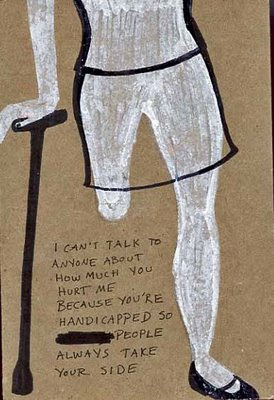
A postcard is an easily identifiable and recognizable social object, distinguished by its regularized size, flatness and double-sided appearance (one side usually presents a visual image of some sort, and on the other a blank space where a message or note is typically written). Sharply contrasted with the expansive format of the letter, a postcard offers scope for brief and compressed linguistic expression. Envelope-less, a postcard is the perfect choice for sending a souvenir whilst on travel (which has been its normative historical function). The postcard, along with letter writing has been replaced by the enabling speedy and efficient capabilities of email and internet communication that which manages to circumvent the postal service altogether.

Accompanied by a precarious art history of its own (eroticized dusky maidens enticing visitors to a South Pacific paradise come to mind as one of many examples), the postcard, has also been exploited for commercial art purposes. Most galleries and museums now cheaply reprint, the most well-known and iconic canonical art images, from Monet to Warhol, onto postcards and make available for purchase.

This is at odds with the use of postcards for the artistic trading activities and processes of exchange that characterized the international mail art network and movement beginning in the 1950s & 60s. Via the postal service, artists gifted and received a multiplicity of ephemera. Ranging from postcards and handmade books or zines to images made from photocopied materials or with rubber stamps, and other found objects and materials usually relegated to the margins of artistic productivity.
(Useful resources for mail art online - Mail-Art, International Mail Art Archives, EMMA)
Based upon ideas surrounding of freely exchanging art objects and critiquing the dominance of art institutions, mail art “focuses [up]on the social context of art production, circulation, and reception, rather than the evaluation of particular works of art” (Gell 3). This focus is closely linked to a contemporary community art project that similarly makes use of postcard format. PostSecret is an ongoing community art project where people mail in their secrets anonymously on one side of a homemade postcard to a postal address. From here they are "posted" onto the PostSecret blog (blogging and mailing postcards as two forms of "posting"). Sharing secrets has extended to artists using video formats and book publications of the collected postcards.
PostSecret is a mixed reality work. Real life experiences and activities, transferring a deep dark secret onto a postcard, are mixed with the virtual activities of, posting the postcards onto the blog itself and users experiencing the art project online. Exposing secrets to wide internet readership and constructing secrets, literally reifying that which is essentially considered to be a ‘feeling’, ‘regret for past action’, or a ‘worry’ into a concrete object, are expressive and "performative" processes, resulting in the production of a vast range of social media objects.
From the humorous and trifling …
... to a confession of either superficiality or desperateness
... to a statement of guilt, perhaps commenting further (and maybe beyond the creator's intention) on the effects of political correctness and the ways in which marginal groups are socially "visible".
If a secret is understood as that which is kept hidden from knowledge or view, that which we kept internalized, concealed, and do not express, our very notion of ‘secret’ or ‘secretness’ must shift when a secret is shared between individuals or materially expressed in some way. The intrinsic format of the postcard makes a posted secret constantly in visible. It cannot be concealed at any stage of the circulation process, between its initial creation, postal processing and reception on the internet.

And yet these "secret-spillers" remain anonymous. Evading vicious gossip discourse, the project protects its creators by making it impossible to discover their identity. But because secrets have been shared and exposed this potential curiosity seems to be already in effect satisfied. Perhaps more importantly considered is the nature of the ‘secret’ itself and our notions of ‘secretness’. Is a secret still a secret when it is expressed and shared with a large audience?
PostSecret writes that “Sometimes a secret we keep from ourselves only becomes true after we read it on a strangers postcard.” The capabilities of social agency instantiated by the project goes beyond the creator’s intention (Gell 3) to perhaps simply "get something off their chest." Reading the secrets of others can potentially make us realise that we perhaps hold that secret too.
Works Cited
Gell, Alfred. Art and Agency: An Anthropological Theory. Oxford : Clarendon Press, 1998.





3 comments:
interesting write up on post secret.
I run to the computer each monday morning to read this blog!
(that is when it is newly updated)
Check this out... http://mashable.com/2008/04/28/postsecret-dmca/
Its an interesting issue I had not thought of... the way corporations rip off ideas from individuals on the one hand, and then commercialize them and attempt to then 'own' them.
And that individuals on the other hand could be more protective of their intellectual property so as to commercialize for their own profit. Incidentally, it appears from the UN Creative Economy report that we are moving beyond 'knowledge' to creative capital.
Post a Comment